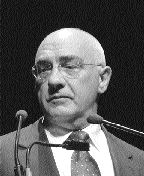Kalgoorlie, Western Australia — While uranium was a much talked about subject at the recent Diggers & Dealers forum, stockbrokers, fund managers and resource bankers in the capacity crowd were merely seeking clones of
Only a few years ago, Jubilee Mines was a penny stock before it discovered high-grade nickel in Western Australia’s northeastern goldfield. And Consolidated Minerals (ConsMin) was the end result of a failed manganese producer in Western Australia’s Pilbara region.
The transformation of these companies has been aided by robust dividends, new discoveries, shrewd acquisitions, and strong metal prices. The pair is drawing the attention of some big Australian fund managers which, in turn, is bringing greater focus on Australia’s mid-tier producers, another option to the healthy, steady returns of
Jubilee Chairman Kerry Harmanis was rewarded for his company’s performance by being selected as Digger of the Year, four years after he won the award following the spectacular Cosmos nickel discovery in the Kathleen Valley area, 30 km north of Leinster in Western Australia. His subsequent presentation promised even more mines near Cosmos.
ConsMin’s Chief Executive Michael Kiernan spiced up his presentation with the announcement of an unaudited A$70.3 million after-tax profit in 2004-05, and a recommendation of a fully franked dividend of A12 per share that would bring the full-year payout to A18 apiece. Kiernan’s numbers include A$19 million from the sale of shares in Portman, an iron miner bought by Ohio-based
Jubilee’s financial performance is still on the bean counter’s production line, however, in the June quarter Harmanis said cash-in-the-bank and receivables stood at A$132 million and that a “generous” dividend would likely be declared in September.
Jubilee’s new Prospero discovery, south of the deepening Cosmos mine, now has a resource of 1.06 million tonnes grading 5.72% nickel.
Like ConsMins, Jubilee has invested some of its burgeoning capital. It holds a 16.15% stake in
ConsMin, meanwhile, has taken over Reliance Mining, which operates the Beta-Hunt nickel mines at the Kambalda complex and sends its ore to the Nickel West concentrator; acquired a position in emerging polymetallic miner
In the meantime, the well-established manganese and chromite mines in the Pilbara are looking at expanding, buoyed by demand from China and elsewhere in Asia.
Other highlights from Diggers & Dealers include:
– The fires of speculation were fanned on rumours that
–
–
– Canadian-listed
– Big-thinking entrepreneur Andrew (Twiggy) Forrest is undaunted by the prospect of establishing his
–
– As the first collier to present at Diggers,
– What will happen to the mammoth, low-grade Boddington gold deposit, south of Perth, Western Australia, now that 22% owner
Elsewhere on the Diggers & Dealers floor,
A brief exploration boom in the 1970s put Australia on the uranium map and in the space of three years the country had 26% of world reserves but several political fumbles eventually handed the wheel in the global uranium supply market to Canada.
Pressure is now be applied to lift Australia’s profile in uranium, with the Prime Minister John Howard coalition Liberal government making it known that trade negotiations with the Chinese has China pushing hard for Australian uranium.
Interest in Australian companies with uranium projects has lifted appreciably in 2005 and gained further momentum when the Howard government made it clear it would veto any Northern Territory efforts to ban new uranium mines. Northern Territory Chief Minister Clare Martin, a former journalist known for her anti-uranium views, recently declared, on the eve of a landslide election victory, that there would be no new yellowcake operations in the jurisdiction.
But the Northern
Territory is very reliant on Canberra, and is not a state.
There are political hurdles elsewhere, too, with the exception of South Australia, which is for any kind of mining. The state reaps revenue from Olympic Dam, the world’s largest hard rock uranium mine, and Beverley, the biggest in situ leach uranium operation.
Just as Diggers & Dealers concluded, Federal Resources Minister Ian Macfarlane said Canberra was setting up a 3-year framework for new uranium developments, including making it easier to mine, explore and export U3O8.
Diggers & Dealers’ venerable session chairman David Reed, in an address at the Forum dinner outlining Australia’s influence in global mineral production, beseeched Western Australia’s Mines Minister Alan Carpenter to change the anti-uranium views held by Western Australia Premier Geoff Gallop. That produced the biggest applause of the program.


Be the first to comment on "Mid-tier miners steal Diggers & Dealers spotlight"